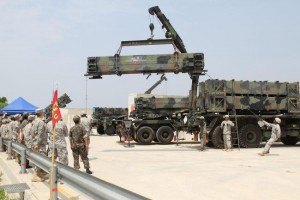2015-10-24 South Korea and US forces are working the offensive-defensive enterprise to deter North Koreans.
One element is enhanced joint training in the ADA capabilities of the two ground forces.
When a siren went off in the afternoon of July 15, Korean and U.S. soldiers moved to a launcher to load a guided missile quickly. Launching members reloaded the Patriot dummy projectile according to the mission manual as a safety control officer controlled the scene. And as a line chief completed the final inspection of loading the guided missile and its function status, a commander issued an order to intercept the target. Using a simulation track for training, this exercise was completed successfully with the virtual enemy aircraft and the ballistic missile hit by our Patriot.
The 8199 unit, the subordinate force of the 2nd Air Defense Guided Missile brigade, and 2-1 battalion, the subordinate force of the U.S. 35th Air Defense Artillery brigade, conducted the “Korea-U.S. air defense combined training” for three days, from July 13 to 15.

This training has been performed since 2013 in order to improve the combined mission capabilities during wartime, and includes equipment deployment and linkage, launcher installation and guided missile reloading, tactical effectiveness evaluation using a virtual enemy aircraft, etc. It has been an especially good opportunity for our military, which carries forward performance improvement of the Patriot, to improve understanding of the PAC-3 system and share know-how of equipment operations.
At the same time, there was an exercise interconnecting the Korea-U.S. ICC engagement control station (ECS). The ICC ECS is the main equipment of the Patriot system and it has a key part in guided missile firing control and firepower distribution. It shares track information captured through the system interface between both countries and prevents simultaneous engagement against the same target, so that it can prevent the use of unnecessary guided missiles and put the focus on firepower for a major defense area.
After the training, both sides had a time to discuss the mutual training evaluation results through a follow-up briefing, shared information and strived for development of mutual weapon system operation.
Taking this opportunity, I’m expecting to have more upgraded Korea-U.S. combined mission capability. We will obtain the U.S. Army’s know-how through continuous mutual exchange and prepare a performance improvement operation soon to be introduced to our military in advance to carry out our duties faithfully to defend our airspace,” said Lieutenant Colonel Kwon Jin-ki, the commanding officer of 8199 unit who led this training.
South Korean Ministry of Defence
7/31/15

